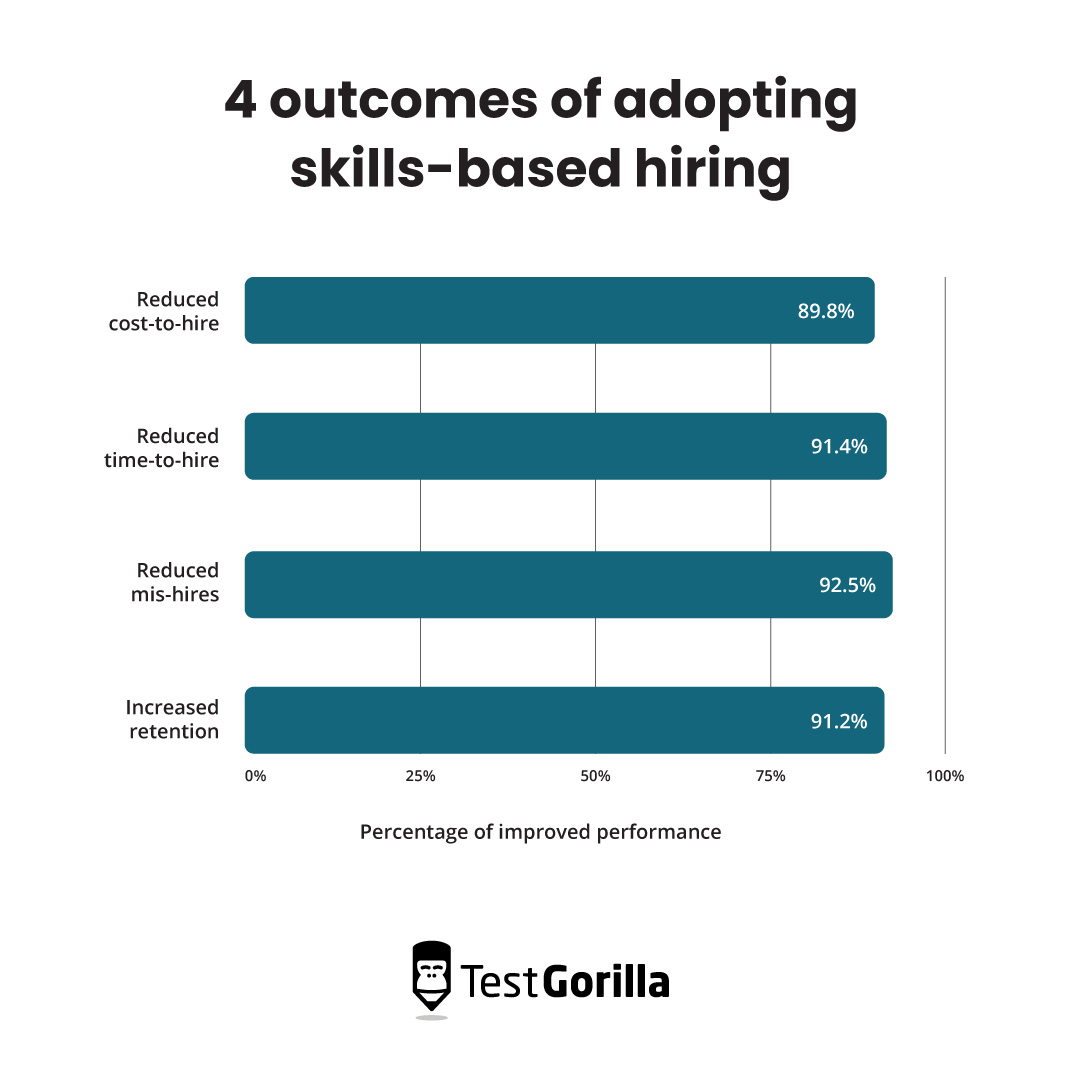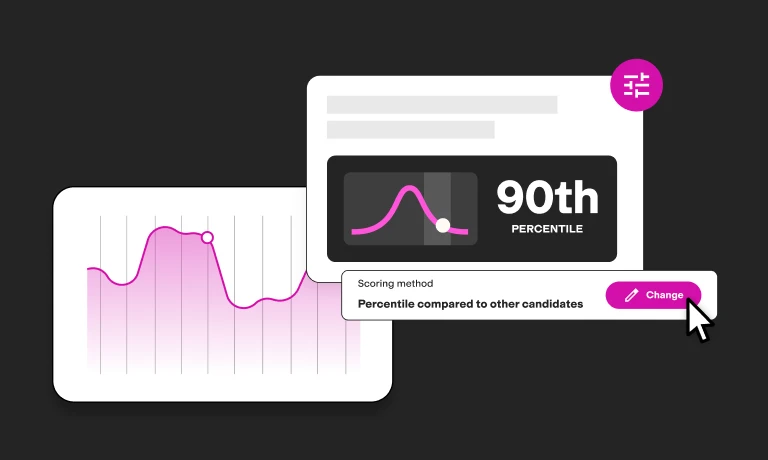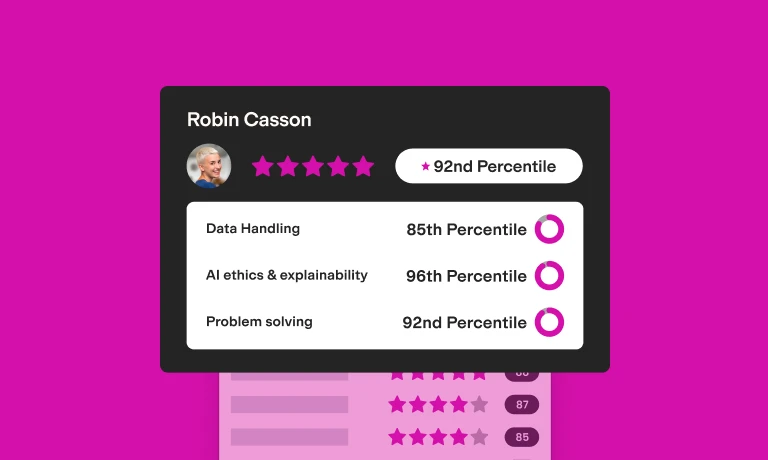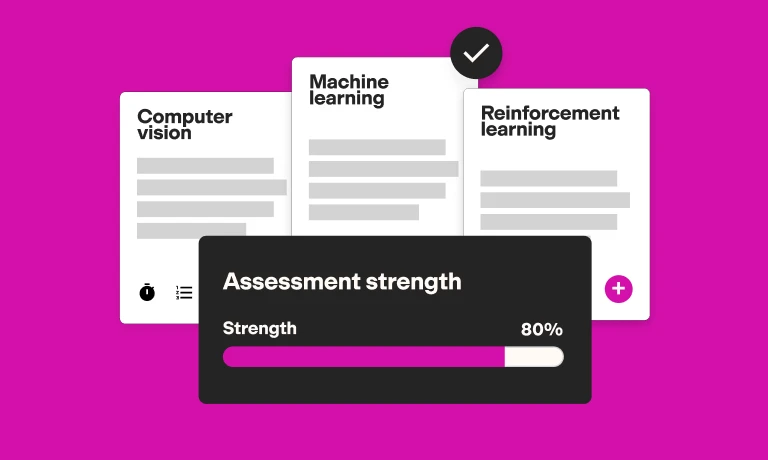How does skills-based hiring affect your recruiting budget?
Sometimes the benefits of skills-based hiring sound too good to be true – lower cost-to-hire for a higher quality employee who stays longer?
By switching to skills-based hiring, thousands of organizations save recruiting costs through higher-quality hires, faster time-to-hire, and longer retention.
We’re here to tell you that skills-based hiring isn’t too good to be true, but it isn’t magic either. Like any new practice, it needs some consideration to properly incorporate into your processes.
Mainly, what’s the overall impact on your recruiting budget?
Adopting a new recruitment method has its costs, and skills-based practices aren’t exempt. But the benefits are real, and in the long term, your organization will save money and improve its workforce with hires who have proven their skills.
Let’s discuss the ways skills-based hiring impacts your recruiting budget, look at the ways it increases and decreases your costs, and make a solid business case on why switching to skills-based practices is the smartest thing you can do for your company’s recruiting budget.
Table of contents
- How adopting skills-based hiring increases your hiring costs
- How adopting skills-based hiring decreases your hiring costs
- How do you calculate the financial benefits of skills-based hiring?
- How does the change in costs from traditional to skills-based hiring compare?
- Reduce your recruiting budget and hire the best with skills tests
- Sources
How adopting skills-based hiring increases your hiring costs
There’s no way around it – new processes cost money.
You can’t feasibly adopt a new hiring process without it impacting your recruiting budget in a few ways, even if the cost isn’t dramatic.
Here’s a quick rundown of both the one-off expenses and ongoing expenses of adopting skills-based hiring.
One-off expenses
The one-off expenses are costs that affect your budget right when you adopt skills-based hiring. They are the one-time costs needed to get your new hiring practices up and running.
These expenses include:
Restructuring your hiring process: Creating new roles, building new responsibilities, and enacting new practices cost money, but improving your processes is an important use of your recruiting budget, especially in the long term
Researching new processes: Researching new processes, collecting data and research, and presenting findings to decision-makers can be a lengthy process that costs hourly wages and opportunities
Implementing new technology: New technology includes costs from the hourly workers implementing it, the time it takes for hiring managers and recruiters to learn it, and the process of data transfer
Planning and scripting structured interviews: Structured interviews are a crucial part of skills-based hiring, but they take time to properly script and determine pass criteria
These points are crucial to the future success of your skills-based hiring practices, so the cost is essential.
But it’s important to remember that these are just one-time costs – after they’re done, they’re done.
Let’s take a look at the ongoing expenses of maintaining skills-based hiring practices.
Ongoing expenses
When it comes to skills-based hiring, there isn’t much to speak of for upkeep costs.
The main ongoing expense is the cost of using pre-employment software, such as skills testing software, video interview software (which you may already be using), and job simulation software.
This includes anything needed to continue the use of your tech, like monthly subscription fees and IT maintenance.
And that’s it. It might sound unrealistic, but it isn’t. Maintaining your software is the only ongoing expense of adopting skills-based hiring.
How adopting skills-based hiring decreases your hiring costs
Skills-based practices decrease your hiring costs in quite a few key ways.
Think of skills-based hiring as one of the best investments your company will ever make. It takes money to get started, but it pays dividends.
We’re going to take a look at how skills-based hiring reduces one-off expenses, ongoing expenses, and small indirect costs.
One-off expenses
Screening resumes manually is a thing of the past for most organizations, unless it’s a small startup. This means most companies need to invest in resume-screening software.
Skills-based hiring reduces the need for resumes. In fact, we recommend getting rid of them entirely and relying on skills tests and structured interviews.
Adopting skills-based practices means there are no more costs from investing in resume screening tech. And the reduced costs don’t end there.
Increasingly more hiring managers are doubting the effectiveness of resumes and realizing they’re unreliable at best.
A recent study found 55% of candidates lie on their resumes, with manufacturing candidates lying the most (72%) and healthcare a close second (64%).
Kicking the resume to the curb improves your overall hiring quality. When you pay for resume screening software, you’re paying the upfront fee and accruing the additional cost of lower-quality hires and mis-hires.
If you think you can handle it, give our 5 stories from resume recruiting hell a read for more information.
Ongoing expenses
Skills-based hiring reduces a large number of ongoing recruiting costs:
Using resume screening tech: This includes the monthly or annual costs, plus the cost of IT maintenance.
Outsourcing recruiters: Skills-based hiring facilitates in-house hiring, decreasing the need for outsourcing recruiters.
Spending too long interviewing candidates: Skills-based hiring streamlines the interview process, decreasing the overall time spent interviewing, and searching for candidates. Interviews can account for 30% to 40% of recruiting costs.
As we mentioned above, adopting skills-based hiring does include the ongoing costs of using pre-employment software, but it reduces far more ongoing expenses than you’re taking on.
Indirect costs
It’s worth mentioning a few of the costs that can only fall under the umbrella of “miscellaneous indirect expenses.”
Here are a few indirect ways skills-based hiring lowers costs:
Reduces fatigue and emotional toll on hiring managers: Dealing with a talent shortage and assessing candidates impacts your hiring managers emotionally. This impact can distract them from their primary responsibilities or cause them to make poor hiring decisions.
Reduces mis-hires: A mis-hire is costly upfront, but it also can cause a ripple effect impacting the productivity and mood of your current employees.
Lowers turnover and reduces employee churn: Skills-based hiring increases retention, reducing your organization’s turnover costs.
Increases agility in response to major change: Skills-based practices improve a company’s adaptability and agility, making detrimental change like the Great Reshuffle easy to adapt to.
Lowers time-to-hire: Removing unreliable resumes and opening the talent pool enable skills-based hiring to find high-quality candidates much faster than traditional methods.
Let’s briefly expand on that last point.
Skills-based hiring streamlines the hiring process and zeroes in on the ideal hire faster than traditional hiring. Our State of Skills-Based Hiring report found 91.4% of organizations that used skills-based hiring in 2022 saw a reduction in time-to-hire.
British-Lithuanian bank Revolut experienced this firsthand. It started using skills tests to evaluate the language proficiencies of its multinational hires and improved its time-to-hire by 40%.
This is the tip of the iceberg on how skills-based hiring decreases your recruiting expenses. For more insights, read our blog on skills-based hiring and lowering costs.
The best insights on HR and recruitment, delivered to your inbox.
Biweekly updates. No spam. Unsubscribe any time.
How do you calculate the financial benefits of skills-based hiring?
Skills-based hiring impacts your hiring budget in many positive ways, and we need that more than ever.
The recruiting world is undergoing many complications, from the aftereffects of the pandemic to the Great Discontent. One of these issues is the rising cost of hiring:
Year | Average cost-per-hire | Executive cost-per-hire |
2022 | $4,683[1] | $28,329 |
2017 | $4,425 | $14,936[2] |
2015 | $4,129[3] | N/A |
The average employee cost-per-hire is gradually rising, but cost-per-hire for executive roles has nearly doubled in the past five years.
These numbers are for the price of hiring and don’t factor in whether or not the candidate works out. And a mis-hire can cost up to 30% of the employee’s first-year earnings.
Here’s an example of the price of an average mis-hire:
Employee’s salary | Cost-per-hire | Mis-hire costs | Total |
$70,000 | $4,600 | $21,000 | $25,600 |
This isn’t even counting the indirect costs of a bad hire, such as opportunity costs, loss of productivity, onboarding costs, and damage to any project they were working on.
Where does skills-based hiring come in?
According to the TestGorilla’s State of Skills-Based Hiring report we mentioned earlier, of companies that used skills-based practices in 2022:
89.8% of organizations saw a reduction in cost-to-hire
92.5% of organizations saw a reduction in mis-hires
Of these companies, 14% saw a huge improvement in reducing mis-hires, 30% saw a significant improvement, and 32.1% saw moderate improvement.
Reducing mis-hires is imperative when 76% of senior managers admit to recruiting the wrong candidate for a role. Mis-hires are detrimental, and they happen every day.
But employees hired via skills-based hiring simply match their roles better. When you assess a candidate’s skills objectively and focus on role-relevant capabilities, you’re much more likely to find the ideal hire.
For more insights, read our article on how skills-based hiring leads to fewer mis-hires.
It isn’t only our research either. A separate study found 78% of HR professionals say the quality of their organization’s hires has improved because of skills assessments.
And better hires mean reduced expenses. The less you hire, the less you spend.
How does the change in costs from traditional to skills-based hiring compare?
Many organizations are discovering the financial benefits of adopting skills-based hiring. But how does it compare to traditional hiring? And how long does it take to see real results?
In the short term, of course, costs are going to be higher. Every time you’re adopting a new process, it’s going to be more costly than using an old one.
Once you start to pick up speed – let’s say that takes about half a year – you’ll start to see results.
But the real benefits become apparent later in the long term.
As we mentioned earlier, skills-based hiring is an investment. It’s in the long-term that your company reaps lower costs, faster time-to-hire, fewer mis-hires, and longer retention.
Skills-based hiring also improves the employee experience and improves satisfaction. Our report showed 72.1% of workers hired via skills-based hiring are happy in their role.
Here’s a side-by-side comparison between adopting skills-based hiring and adopting traditional hiring:
Time frame | Skills-based hiring | Traditional Hiring |
Short-term | Higher costs due to: Sourcing pre-employment software. Designing structured interview scripts. Restructuring your hiring processes | Lower costs due to: Choosing a common, “tried and true” system. Implementing common software |
Medium-term | Costs begin to even out due to: No more one-off expenses. Starting to get your first skills-based hires. The only payments being for using software | Costs begin to rise due to: Outsourcing recruiters. Hiring managers burning out |
Long-term | Costs reduce due to: Hiring higher-quality employees. Retaining great employees for longer. Reducing mis-hiresHiring employees faster | Costs stay high due to: Hiring lower-quality staff. Increasing employee turnover. Increasing numbers of mis-hires. Hiring employees more slowly |
With skills-based hiring, the expected payback period is one to two years.
According to TestGorilla’s State of Skills-Based Hiring report, of the companies we surveyed, 58% of them had only adopted skills-based hiring in the past one to two years.
What’s the outcome? These are the amazing results:.
89.8% of organizations saw a reduction in cost-to-hire
91.4% of organizations saw a reduction in time-to-hire
92.5% of organizations saw a reduction in mis-hires
91.2% of organizations saw an increase in retention
We had the chance to talk with many of the organizations that reaped these benefits. One of them is Paul Abercrombie, the director of talent at Klaviyo.
Paul says Klaviyo adopted skills-based hiring in early 2022 and began to see results fast. It sped up their recruitment process and gave candidates equal opportunities, reducing bias and widening the talent pool.
Traditional hiring is on its way out, along with dated practices and processes that drain your recruiting budget instead of saving it.
Skills-based hiring is the future, and the sooner companies adopt this innovative process, the better.
Reduce your recruiting budget and hire the best with skills tests
Your recruiting budget is a crucial element in your overall hiring strategy, and reducing costs wherever possible is essential.
With skills-based hiring, you not only reduce costs, but also improve the quality of your hires, reduce mis-hires, and boost retention.
It takes a little time to see the full payout, but in the long term, it’s one of the best investments you can make.
If you’d like to keep exploring this topic, check out our blog on how to properly plan an HR budget.
To evaluate a candidate’s ability to maximize profits and minimize risk, read about our Financial Management test.
Sources
Miller, Stephen. (April 11, 2023). “SHRM HR Benchmarking Reports Launch as a Free Member-Exclusive Benefit”. SHRM. Retrieved May 23, 2023. https://www.shrm.org/resourcesandtools/hr-topics/benefits/pages/shrm-hr-benchmarking-reports-launch-as-a-member-exclusive-benefit.aspx
“SHRM Customized Talent Acquisition Benchmarking Report”. (2017). SHRM. Retrieved May 23, 2023. https://www.shrm.org/ResourcesAndTools/business-solutions/Documents/Talent-Acquisition-Report-All-Industries-All-FTEs.pdf
“SHRM Benchmarking Report: $4,129 Average Cost-per-Hire”. (August 8, 2016). SHRM. Retrieved May 23, 2023. https://www.shrm.org/hr-today/news/hr-news/pages/shrm-benchmarking-report-$4,100-average-cost-per-hire.aspx
You've scrolled this far
Why not try TestGorilla for free, and see what happens when you put skills first.

















